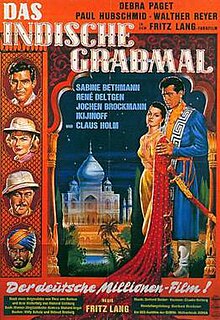fiction.wikisort.org - Movie
The Indian Tomb (Das indische Grabmal in its original German) is a 1959 West German-French-Italian adventure drama film. It was produced by Artur Brauner, directed by Fritz Lang, and stars Debra Paget, Paul Hubschmid, Walter Reyer, Claus Holm, Valéry Inkijinoff, and Sabine Bethma.
| The Indian Tomb | |
|---|---|
 German theatrical release poster | |
| Directed by | Fritz Lang |
| Screenplay by | Thea von Harbou Fritz Lang Werner Jörg Lüddecke |
| Based on | Das indische Grabmal by Thea von Harbou |
| Produced by | Artur Brauner |
| Starring | Debra Paget Paul Hubschmid Walter Reyer Claus Holm Valéry Inkijinoff Sabine Bethmann |
| Cinematography | Richard Angst |
| Edited by | Walter Wischniewsky |
| Music by | Gerhard Becker Michel Michelet |
Production companies | Central Cinema Company Rizzoli Film Regina Production Critérion Film |
Release date | 1959 |
Running time | 102 minutes |
| Countries | West Germany France Italy[1][2][3] |
| Language | German |
It is the second of two feature films, comprising what has come to be known as Fritz Lang's Indian Epic; the first is The Tiger of Eschnapur (Der Tiger von Eschnapur). Both are based on the novel Das indische Grabmal, written by Lang's ex-wife, Thea von Harbou, who died in 1954. In 1960 American International Pictures obtained the rights to both films and combined them into one heavily-edited, 90 minute long feature renamed Journey to the Lost City. After both were dubbed into Spanish, they were shown as separate films, when in fact the second was a direct continuation of the first.
Interiors were shot at the Spandau Studios in West Berlin with sets designed by the art directors Helmut Nentwig and Willy Schatz.
In popular culture
The film is probably best remembered today for Debra Paget's erotically charged "snake dance scene".
Reception
On review aggregation website Rotten Tomatoes, the film had an approval rating of 88% based on 8 reviews.[4] Die Welt wrote: "Here lies Fritz Lang, once creator of important films like Metropolis and M. The 'Indian tomb' is his own." [i.e, grave as a filmmaker][5] In contrast to those earlier opinions, contemporary American film critics are positive about the film.[6]
See also
- The Indian Tomb (1921 film)
Notes
- Mannikka, Eleanor. "The Indian Tomb". Allmovie. Rovi Corporation. Retrieved February 18, 2013.
- "Das indische Grabmal". BFI Film & Television Database. London: British Film Institute. Archived from the original on February 7, 2009. Retrieved February 18, 2013.
- "Das indische Grabmal". Filmportal.de. Retrieved February 18, 2013.
- "The Indian Tomb (1959)". Rotten Tomatoes. Fandango Media. Retrieved January 28, 2022.
- Der deutsche Film der fünfziger Jahre, Heyne Filmbibliothek, 1987, page 170.
- "The Indian Tomb" at Rotten Tomatoes
External links
- The Indian Tomb at IMDb
- A Clip on YouTube from The Indian Tomb (Debra Paget dancing with a cobra)
- "Three and a half Tombs" - article about the genesis of the book and the films made from it
- "Come On, Baby, Be My Tiger" - article about the several versions of the film
- Artur-Brauner-Archive at the Deutsches Filmmuseum in Frankfurt (German), containing the production files for this movie
На других языках
- [en] The Indian Tomb (1959 film)
[ru] Индийская гробница (фильм, 1959)
«Индийская гробница» (нем. Das Indische Grabmal) — приключенческий фильм 1959 года немецкого режиссёра Фрица Ланга, снятый в по мотивам романа Теа фон Гарбоу. Фильм является продолжением картины «Бенгальский тигр».Другой контент может иметь иную лицензию. Перед использованием материалов сайта WikiSort.org внимательно изучите правила лицензирования конкретных элементов наполнения сайта.
WikiSort.org - проект по пересортировке и дополнению контента Википедии